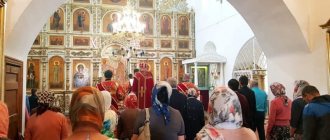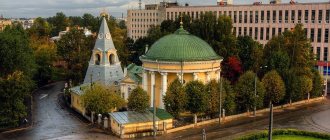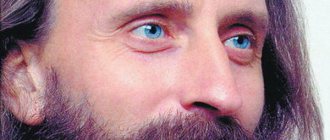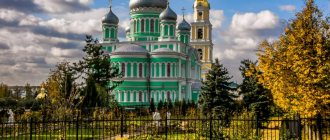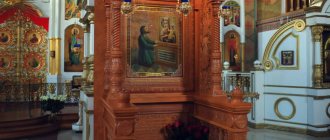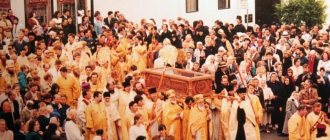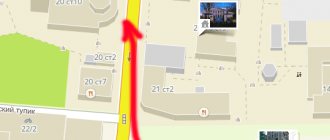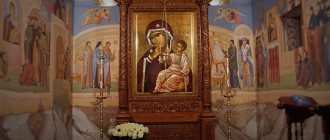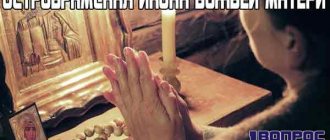The miraculous image of “Joy to All Who Sorrow” is located in the church on Ordynka. The first mention of it in literature dates back to the end of the 17th century. Scientists have not been able to identify the author.
The Icon of All Who Sorrow Joy is a miraculous image, one of the most revered in Russia. On it the Most Pure Virgin is depicted as an intercessor and comforter of people. Believers turn to Her in prayers asking for protection. The image is more than four hundred years old. During this time, many people received healing from illnesses, and also got rid of other sorrows thanks to the power of righteous prayer.
How the icon of Joy of All Who Sorrow helps: meaning, miracles
Figure 1. Prayer in front of the icon
From the numerous stories associated with this image, it is clear that it is not the icon itself that has the power of healing, but a sincere prayer in front of it, which is addressed to the Mother of God. There are many known cases when believers asked the Virgin Mary for healing from various serious illnesses, and She appeared to them and advised them to visit the temple where this icon of the Mother of God was located. After praying before the holy face in this church, the Orthodox were delivered from their infirmities.
It is important to remember that it is not the icon itself that performs miracles, but the Lord, at the request of his Most Pure Mother, to whom Christians resort as a comforter and intercessor.
The appearance of a miraculous shrine
Figure 2. Church of the Transfiguration
It is not known for certain who is the author of this iconographic image of the Mother of God. The first mention of it in literature dates back to the end of the 17th century. Entries in church books tell of healings that occurred after prayer before the miraculous image in the Church of the Transfiguration in Moscow.
By that time, no one could say exactly how the shrine got into that temple. Some scientists involved in the history of the Orthodox Church suggest that the image appeared in the church on Ordynka after a new stone one was erected in 1685 on the site of the old wooden church. Most likely, at this time the ancient image came here, which before that was either in the iconostasis of the previous church that stood here, or was the property of some other parish.
Icon of the Mother of God “Joy of All Who Sorrow” (with pennies) (memory day - August 5)
The variety of icons of the Mother of God is amazing. And although some experts call the number about seven hundred, no one knows for sure how many there are in reality. As the legend about the life of the Mother of the Savior says, “icons of the Mother of God are like stars in the sky: their number is known only by the Queen of Heaven Herself.” Sometimes copies of one famous icon appear that become miraculous. People are healed from serious illnesses, and the new icon is glorified. This happened with the image of “Joy to All Who Sorrow” (with pennies).
First, let’s dive into the history of the iconography of “Joy to All Who Sorrow.” This image appeared in Russia in the 17th century, although under the influence of Western European works. We must pay tribute to the Russian icon painters, who very creatively reworked Catholic creations. The title was the beginning of the Mother of God stichera: “Joy to all who mourn and the offended intercessor...”.
The first written mention of an icon with this name appeared in 1683. The author is listed as the court painter Ivan Bezmin. Five years later, in Moscow, before the face of the Mother of God “Joy of All Who Sorrow,” located in the Transfiguration Church on Ordynka, Evfemia Petrovna Papina was healed of a serious illness. She was the sister of the Patriarch of Moscow and All Rus' Joachim (Savelov). After intensive prayer in front of the image, the woman regained her health. The miraculous healing occurred on November 6, and in memory of this, a celebration was established in honor of the icon “Joy of All Who Sorrow.” The temple itself, in which the miracle took place, soon became famous throughout the capital under the name “Sorrowful”. The icon “Joy of All Who Sorrow” fell in love with people and spread throughout Rus'.
How one of the icons ended up in the Neva is unknown, but one day one of the representatives of the St. Petersburg Kurakin family found it washed up by the waves on the river bank. The image was kept for a long time as a family heirloom. It would have stood like that in the home iconostasis, if not for the miraculous rescue of a descendant of this family during a storm. He was the only survivor after the boat capsized during a strong storm. Clinging to a board right in the middle of the Neva, he prayed to the Mother of God for salvation. A side wind blew, and the board with the drowned man was nailed to the place where the Tikhvin Chapel stood. The grateful merchant Semyon Ivanovich Matveev, after returning home, donated the icon “Joy of All Who Sorrow” to a small chapel in the village of Klochki on the outskirts of St. Petersburg. Nowadays it is a historical part in the Nevsky district of St. Petersburg, between the Neva River, the Connecting Railway Line, the Okkervil River and Kollontai Street.
It was in the Tikhvin chapel in the summer of 1888 that a miracle happened. On August 5, a thunderstorm broke out over St. Petersburg. Lightning struck the chapel with crushing force and burned all the internal walls and decorations... with the exception of the donated Sorrowful Icon. An amazing picture appeared before the eyes of eyewitnesses: the face of the Mother of God on the icon was renewed. Previously darkened by time and the soot of candles, it was now brightened. A donation mug standing next to the icon was shattered, money scattered on the floor, and 12 copper coins stuck to the image in different places (later 1 coin fell off). The pennies remained on the surface of the icon for no apparent reason - as evidence of a miracle of God.
Rumors about the unusual incident quickly spread around the area, and the very next day pilgrims flocked to the chapel. Miracle healings began. Two miracles were officially documented and confirmed. Two years after the discovery of the icon, in 1890, a young man named Nikolai Grachev recovered. He suffered from epilepsy, which in those days was called epilepsy. The guy had an amazing dream: the Most Holy Theotokos and St. Nicholas the Wonderworker of Myra appeared before him, and someone’s voice sounded: “Go to the chapel where the coins fell, and you will receive healing. But don’t tell anyone anything in advance.” In front of the astonished parishioners, the youth, coming up and venerating the image, was forever healed of his illness.
The second miracle was the recovery of the young woman Vera Belonogina. In our times, tuberculosis can be cured, but at the end of the 19th century, tuberculosis patients faced a painful death. This fate also hung over the beautiful Vera, the beloved wife of a clerk who worked at the Thornton cloth factory. At first the woman simply lost her voice. The doctors thought it was pharyngitis, but nothing helped - the unfortunate woman was wheezing, her voice did not return. And it became clear that the woman was struck by a terrible illness - laryngeal consumption (as laryngeal tuberculosis was then called). The doctors threw up their hands, and Vera began to rely on God with all her might. Once in a dream, a woman heard a voice commanding her to go to the chapel. After a prayer service at the miraculous icon “Joy of All Who Sorrow” (with pennies), she entered the house and loudly said to her husband from the threshold: “I am absolutely healthy!”
Soon a new type of icon “Joy of All Who Sorrow” appeared, on which pennies began to be written with paint. The celebration in honor of the icon was established on August 5, the day of its miraculous transfiguration. In the image itself, the Mother of God is surrounded by needy people - the poor, the sick, the hungry, and among them are angels. The Intercessor herself is depicted on the icon in full height, in a red and blue robe and with a white scarf on her head. The Savior sits above her in the clouds, in His left hand is the Gospel, and in His right hand He blesses people.
After that remarkable (there is no other way to describe it) fire, a temple was built in honor of the miraculous icon on the site of the burnt chapel. Moreover, the charred former chapel was left inside, and a large stone chapel in the Russian style became its “case”. At that time, it turned out to be the largest chapel in Russia, as it could accommodate up to 800 people. Unfortunately, less than 20 years later she was gone. After the revolution of 1917, the Church of Sorrows was blown up. Fortunately, the believers were able to hide the miraculous icon and secretly keep it from the communists. During the Great Patriotic War, it was possible to open access to the holy image. It was installed for worship in the Holy Trinity Church. During the years of the terrible blockade, during inhuman suffering, the residents of Leningrad so needed the consolation and strengthening of the Mother of God. And many later testified how they received help from the Mother of God after praying in front of the icon.
Nowadays the image is kept in the same church of the Holy Life-Giving Trinity. If you go on a pilgrimage to St. Petersburg, you can venerate the shrine on Obukhov Defense Avenue. You certainly won’t pass by the church: for its unusual appearance it is called “Kulich and Easter”.
05.08.2018
Description of the icon and the meaning of the miraculous image
Figure 3. Joy to all who mourn (with pennies)
It is no coincidence that the word “joy” in the name of this shrine is written with a capital letter. This is how the author calls the Mother of God herself, who truly brings comfort to everyone in need and sorrow. History knows many examples when people who came to pray before the face of the Blessed Virgin received help thanks to their faith. Sometimes the Lord gave people much more than they asked for while standing before the holy face. That is why the Heavenly Lady is called Joy here.
On this icon you can see Her full-length image.
Important! There are many versions of the “Joy to All Who Sorrow” icon.
On some of them, the Mother of God holds a scepter (a sign of her power) in her right hand, and the Child Christ in her left. Sometimes the Virgin Mary is depicted without little Jesus. In this case, she is drawn with outstretched arms. Most often, near the Virgin you can see Christians turning to Her with a prayer for healing and consolation. The angels surrounding the Mother of God and among people point their fingers at Her.
This gesture means that it is the Mother of God who is the source of eternal joy for believers. The clothing of the Mother of God on different copies of this icon differs from each other. Sometimes the Virgin Mary is depicted in royal attire. In some versions of the icon “Joy of All Who Sorrow,” the Mother of God appears in a more modest vestment, characteristic of the inhabitants of Palestine during the times of the Gospel events.
In the image, which is located in the Moscow Church on Ordynka, under the Virgin’s feet there is a stone scroll on which the text of the kontakion for this image is written.
Among the people turning to her with prayers are several saints (they can be distinguished by their halos). The Mother of God herself is depicted not only with a radiance near her head. Her entire figure is surrounded by light. This type of halo is called a mandorla. Above the Blessed Virgin there is usually an image of Jesus Christ or God the Father.
Description of the icon “Joy of All Who Sorrow” with pennies
This image differs from the “Joy of All Who Sorrow” icon, from which the list was made. In contrast to the prototype, the Mother of God is depicted without the Infant. But the meaning is the same - the Most Holy Theotokos helps those who ask Her for help, the poor, the sick, the hungry, the naked, the wanderers. Her head is turned to the right, her arms are raised up. On the head is a white omophorion. In one version, She holds a scepter with her right hand as a symbol of power, and with her left hand she gives bread to an angel, who gives it to the poor.
Around the Most Pure Mother of God there are angels who clothe the naked, feed the hungry, persuade them to pray to the Most Holy Theotokos, and console the sick. She stands on a cloud (in another version - on a hill). Behind Her shoulders are sheaves of bread, in another version – mountains. At the top there are inscriptions, words from the troparion to the icon: “ robe for the naked, healing for the sick, Intercessor for the offended, Nurse for the hungry .”
At the very top of the icon is the Lord Almighty blessing from heaven. There are eleven coins around the face of the Mother of God (the twelfth fell from the icon).
Cases of healing from the icon
The very first to be healed from the miraculous image was the youth Nikolai Grachev. He had epileptic seizures and suffered greatly. One night he heard in a dream the head of St. Nicholas the Wonderworker : “Go to the chapel where there is an icon with coins, and you will be healed from it.” And so it happened. The youth went to the chapel, venerated the icon and recovered.
Then the Scribe's wife named Vera received healing. She lost her voice due to consumption of her throat. At night she heard a voice telling her to go to the chapel. In the morning Vera went, venerated the miraculous icon and recovered forever.
There are numerous other cases of healing through prayers to the Most Pure One near this icon.
Days of veneration of the image
Figure 4. In the Transfiguration Cathedral
The Orthodox Church celebrates the feast of this image on November 6 according to the new style. Some lists of icons located in different cities of Russia have their own days of veneration. Thus, the church set a separate date for the icon “Joy of All Who Sorrow (with pennies),” which is located in St. Petersburg. The holiday of this image is August 5th.
The history of the appearance of the icon
In Moscow, in the Church of the Transfiguration on Ordynka, for a long time there was a miraculous icon “Joy of All Who Sorrow.” Miracles of healing from it began in 1688. The first to be healed was the sister of Patriarch Joachim. Then the sister of Tsar Peter the Great, Natalya, ordered that a copy of this miraculous icon be made and brought it to St. Petersburg. This was in 1711.
A copy of the icon was placed in the Transfiguration Cathedral in St. Petersburg. Since then, many lists of this miraculous image have begun to appear. One of them is the icon “Joy of all who mourn with pennies.”
In the second half of the eighteenth century, a chapel was erected on the Shlisselburg tract near the Glass Factory. In it stood the miraculous icon of the Mother of God “Tikhvin”. According to legend, the image was found in the waters of the Neva.
During the flood, the chapel was carried to the other side of the river in the village of Klochki. She remained there, and a new one was built on the site of the old chapel. The Tikhvin Icon was moved there from the old chapel.
Generic image of “Joy of All Who Sorrow”
One day the merchant Matveev was sailing on a boat along the river when a strong storm began. His boat was capsized by the waves and he was on the verge of death. Then he cried out to the Most Pure One, and as a result he was carried ashore near the Tikhvin Chapel. As a token of gratitude, he decided to place in this chapel the generic image of “Joy of All Who Sorrow.” This was one of the lists of the miraculous icon. According to legend, the merchant's ancestors found her on the banks of the Neva.
In 1888 there was a fire in the chapel. The icon “Joy of All Who Sorrow” fell straight into the donation box. Inexplicably, twelve coins stuck to it and were forever imprinted on the image. It is interesting that not a single coin covered the face of the Most Pure One, and the icon itself was renewed after the fire .
Soon miracles of healing began to occur from this icon. Emperor Alexander III was passing through this chapel in 1893 and prayed for a long time before the miraculous image. He ordered a church to be built for the icon. In 1899, it was built and became known as “Skorbyashchenskaya”. However, the icon remained in the chapel, and only sometimes it was transferred to the Sorrow Church for services.
Where is the icon
There are many lists of miraculous images. They are located in different cities of Russia.
The original can be seen in the capital's Church of the Transfiguration. This church on Ordynka is popularly known as Skorbyashchenskaya. There is a legend that the image, revered in Orthodoxy, was transported to St. Petersburg by Princess Natalya Alekseevna. But this version has no evidence.
Figure 5. Icon in the Church of the Transfiguration
Therefore, those who wish to pray in front of the miraculous icon should visit the Church of the Transfiguration in Moscow. The image is located in the limit dedicated to it.
Catalog of icons on the website PravIcon.com
Description of the icon of All Who Sorrow Joy With Pennies
Source: Disc “Orthodox Church Calendar 2011” from the publishing house of the Moscow Patriarchate [2011]
The icon of the Mother of God “Joy of All Who Sorrow” (with pennies) became famous in 1888 in St. Petersburg, when during a terrible thunderstorm lightning struck the chapel , but the holy icon of the Queen of Heaven located in it, which is a copy of the icon of the Mother of God “Joy of All Who Sorrow,” which Princess Natalia Alekseevna (sister of Peter the Great) brought from Moscow, remained intact. The image, until that time with a face darkened by soot, was renewed and brightened. Only the cord on which the holy icon hung in the corner of the chapel was burned, and several small copper coins (pennies) from a broken alms mug stuck to the surface. Since then, many sick and suffering people, who resorted to the Most Blessed Lady with sincere faith and fervent prayer, received healing before Her holy image. In 1898, a church was built on the site of the chapel.
Icon of All Who Sorrow Joy With Groshiki - description
Source: Website “Miracle-Working Icons of the Most Holy Theotokos”, author - Valery Melnikov [2011]
The icon of “ALL WHO SORRY JOY” from the chapel of the glass factory in St. Petersburg received an addition to its name: “with pennies”. This image became famous in 1888 in St. Petersburg, when during a thunderstorm lightning struck the chapel and hit the place where the icon of the Mother of God “Joy of All Who Sorrow” stood. But the icon remained unharmed, only 12 copper coins (pennies) from a broken donation mug were attached to it. Moreover, the previously smoky icon was renewed and brightened. After this, several healings of terminally ill people occurred at the icon. Subsequently, a temple was built in honor of the famous icon on the site of the chapel. After the revolution, the Sorrow Church was closed and then blown up. The miraculous icon was kept in a family of believers, and after the Great Patriotic War it was transferred by them to the Holy Trinity Church, popularly called “Kulich and Easter,” where services were resumed. After the Sorrow Chapel was revived, which became the metochion of the Holy Trinity Zelenetsky […]
“Joy to all who mourn” near the Glass Factory in St. Petersburg (description from the Book of the Villager)
Source: Book “E.
Villager. Our Lady. Description of Her earthly life and miraculous icons” [1914] Recently, the icon “Joy of All Who Sorrow”, located in the village of Klochki, near St. Petersburg, not far from the Glass Factory, has become famous. This image first stayed in the chapel and was donated here by one merchant Matveev, who had his own trade at the Glass Factory. Previously, this icon was the family property of the Kurakin merchants, from whose family Matveev’s mother came. A pious legend says that the image, from nowhere, sailed along the Neva to the place of transportation across this river and here, washed up by the waves, it was taken by Kurakin. The glorification of the icon followed for the first time on July 23, 1888. On this day, a terrible thunderstorm broke out over St. Petersburg and its environs. Lightning struck the chapel at the Glass Factory with force, burned the interior walls, but did not touch the image of the Mother of God, despite the fact that other icons were scorched by the flames and the alms cup was completely broken. The image of the Lady was attached to the chapel in the corner on a cord. The icon fell from a thunderclap[...]
Prayer to the icon
For each particularly revered image there is a separate prayer, which is best addressed to the saint, Virgin Mary or Lord depicted on it. In addition, during the service on the feast day of each image, a troparion and kontakion are read, dedicated to the image revered by the church. Also in the church these days you can hear an akathist to the icon. You can also read it at home.
As for prayers, it is best to look for them in special collections - prayer books.
Moreover, you should choose those books that are recommended or approved for publication by the Russian Orthodox Church.
How does the icon help and who does it patronize?
The image helps to tune in to the correct prayer of the Mother of God. You can turn to the Ever-Virgin with any request, but it is believed that prayer in front of this icon best contributes to the onset of a long-awaited pregnancy. It is also customary to offer prayers to the Mother of God for the physical and spiritual health of family and friends.
What do they pray for in front of the icon?
The first case of miraculous healing associated with the image of “Joy to All Who Sorrow” occurred in the 17th century, when a woman living in Moscow asked the Mother of God to help her get rid of terrible pain in her side. One day, the Virgin Mary appeared to her and said that she should pray in front of the icon in the church on Ordynka. The woman went to the temple. After fervent prayer in front of the image, she was completely cured of her illness. There is also a known case when prayer in front of this icon helped a youth get rid of an epileptic fit.
How to pray to the holy image correctly
You need to turn not to the icon itself, but to the Mother of God who is depicted on it. When expressing your requests, you should not limit yourself only to pleas for physical health, because everyone also has spiritual ailments, called sins.
Prayer should be imbued with a sense of humility, reverence and reverence for the Lord, the Mother of God or the saints.
Before the icon “Joy of All Who Sorrow” it is customary to read the following prayers.
Prayer to the Most Holy Theotokos in front of Her icon “Joy of all who mourn.”
Prayer to the Most Holy Theotokos before Her Icon “Joy of All Who Sorrow”
Oh, Most Holy Lady and Mother of God, Most High Cherub and Most Honest Seraphim, God's Chosen Maiden, Reclamation of the lost and Joy to all who mourn! Give consolation to us, who are in perdition and sorrow; Have you no other refuge and help than the imams? You alone are our Intercessor of joy, and as the Mother of God and the Mother of Mercy, standing at the Throne of the Most Holy Trinity, you can help us, for no one who comes to You leaves in shame. Hear us now, on the day of destruction and sorrow, before Your icon, falling down and praying to You with tears: take away from us the sorrows and troubles that are upon us in this temporary life, and make us not deprived. Your all-powerful intercession and eternal endless joy in the Kingdom of the Son and God ours. Amen.
Second prayer to the Most Holy Theotokos before the icon of Her “Joy of All Who Sorrow”
Oh, Most Holy and Most Blessed Virgin, Lady Theotokos! Look with Your merciful eye on us, standing before Your holy icon and praying to You with tenderness; raise us up from the depths of sin, enlighten our minds, darkened by passions, and heal the ulcers of our souls and bodies. There are no imams of other help, no imams of other hope, except for You, the Lady. You weigh all our weaknesses and sins, we resort to You and cry out: do not leave us with Your Heavenly help, but appear to us ever and with Your ineffable mercy and bounty, save and have mercy on us who are perishing . Grant us correction of our sinful life and deliver us from sorrows, troubles and illnesses, from sudden death, hell and eternal torment. You, Queen and Lady, are the quick Helper and Intercessor of all who flow to You and the strong refuge of repentant sinners. Grant us, O Most Blessed and All-Immaculate Virgin, the Christian end of our life to be peaceful and shameless, and grant us, through Your intercession, to dwell in the Abodes of Heaven, where the unceasing voice of the vain with joy he glorifies the Most Holy Trinity, the Father and the Son and the Holy Spirit, now and ever, and unto the ages of ages . Amen.
Third prayer to the Most Holy Theotokos before the icon of Her “Joy of All Who Sorrow”
Oh, Most Blessed Lady, Protector of the Christian race, refuge and salvation of those who resort to You! We know, truly we know, how much we have sinned and been angry, O Most Merciful Lady, the Son of God was born in the flesh of You. But to the imams there are many images of those who angered His mercy: tax collectors, harlots and other sinners, to whom forgiveness of sins will be given for the sake of repentance and confession. Thou art, therefore, imagining the images of those who have been pardoned by the hand of my sinful soul, and looking upon the great mercy of God, which I have received, I am bold, and I, a sinner, will run with repentance to Thy blessing. diyu. Oh, All-Merciful Lady! Give me a helping hand and ask Your Son and God with your motherly and most holy prayers for forgiveness of my grave sin. I believe and confess that He Whom You gave birth to, Your Son is truly Christ, the Son of the living God, Judge of the living and the dead, rewarding everyone according to his deeds; I believe again and confess that You are the true Mother of God, the source of mercy, the consolation of those who mourn, the recovery of the lost, a strong and unceasing intercessor to God, who loves the Christian race dearly. ́nsky, and the wrangler of repentance; Truly, there is no other help and protection for us except You, Most Gracious Lady, and no one else, trusting in You, was ashamed when, and by You begging God, no one was quickly abandoned. For this sake, I pray to Your innumerable goodness: open the doors of Your mercy to me who have gone astray and fallen into the darkness of the depths, do not disdain my filth, do not despise sinful prayer mine, do not leave me, the accursed one, for an evil enemy is looking to kidnap me into destruction, but beg for me Your merciful Son and God, born of You, may He forgive my great sins and deliver me from my destruction, as yes and I, with all who have received forgiveness, will sing and glorify the immeasurable mercy of God The living and Your unashamed intercession for me in this life and in the endless eternity . Amen.
Fourth Prayer to the Most Holy Theotokos before Her Icon “Joy of All Who Sorrow”
Best regards to my queen, my hope, Mother of God, friend to the orphans and the strange, representative! Joy to the grieving, to the offended Patroness! See my misfortune, see my sorrow: help me as I am weak, feed me as I am strange. I have weighed my offense, resolve it, as I wished: for I have no other help except You, no other Representative, no good Comforter, only You, O Mother of God, for save me and cover me in all things for centuries. Amen.
Fifth prayer to the Most Holy Theotokos before Her icon “Joy of All Who Sorrow”
Zealous Intercessor, Compassionate Mother of the Lord, I resort to You, the accursed one and the most sinful of all people; Hear the voice of my prayer, hear my cry and groaning. For my iniquity has exceeded my head, and I, like a ship in the depths, am plunging into the sea of my sins. But You, All-Good and Merciful Lady, do not despise me, desperate and perishing in sins; have mercy on me, who repent of my evil deeds, and turn my lost, cursed soul to the right path. On You, my Lady, Mother of God, I place all my hope. You, Mother of God, preserve and keep me under Your roof, now and ever and unto ages of ages. Amen.
It is important that a person has the right attitude towards prayer. We must remember that the Lord knows our needs and no matter what happens, we should see His will in it.
“Joy to All Who Sorrow”: history, iconography, miracles
Since ancient times, our people have resorted to praying to the Most Holy Theotokos; hundreds and thousands of icons, called miraculous, testify to faith in the intercession and intercession of the Virgin Mary before God for all the unfortunate, deprived, deceived, and suffering.
One of these icons, special veneration of which falls on November 6 according to the new style, is called “Joy to All Who Sorrow.”
The history of the miraculous image
At the end of the 17th century there lived a widow, Euphemia, who was also the sister of Patriarch Joachim of Moscow. She was seriously ill for a year. The doctors could not help her and the woman was already preparing for death. One day, while praying, she heard the voice of the Mother of God. She was told to find in the Church of the Transfiguration an icon called “Joy of All Who Sorrow.” In front of this icon, it was ordered to serve a prayer service for the blessing of water to heal the pious widow from a fatal illness. At the same time, the Mother of God asked not to forget to do works of mercy, so that Her name would be glorified in this.
This was the first time Euphemia had heard such a name for the icon, but she obeyed the voice and the icon was found. The widow's relatives actually found such an image in the indicated temple. Euphemia asked to bring the icon to her house and after the prayer service she received the long-awaited healing. The miracle occurred on October 24, 1688, and since then prayers at this icon have resulted in many miraculous healings.
Even at that time the icon was quite dilapidated. After finding it and healing Euphemia, it had to be restored and strengthened with cypress inserts.
This story was preserved thanks to the written source “The Tale of the Icon”; it was written immediately after the miraculous events. At the same time, a service to the icon “Joy of All Who Sorrow” was written; the akathist was compiled in 1863. This icon is also revered by Old Believers, although the iconography of the image was formed after the reformation of Patriarch Nikon.
According to some information, the first miraculous icon disappeared without a trace, and the icon donated by Patriarch Alexy I to the temple on Ordynka and kept there to this day is an exact copy of the 18th century. At the same time, services in honor of the icon “Joy of All Who Sorrow” were resumed.
Iconography of the image
An exact measuring list from the miraculous icon from the Sorrow Church on Ordynka (last quarter of the 18th century).
Photo: wikipedia.org A special feature of the Moscow icon “Joy of All Who Sorrow” is the image of the Virgin Mary and Child above the suffering with the saints Sergius of Radonezh, Gregory Decapolite, Theodr Sikeot, and Varlaam of Khutyn standing before Her. Suffering people turn to the Mother of God with their ailments and sorrows.
Above the Virgin Mary are depicted angels with ripids above the Virgin Mary in the radiance of a mandorla. At the very top is the Fatherland - an iconographic image of the Trinity. At the base is written a kontakion dedicated to the icon.
Famous lists and miracles
Icon of Princess Natalya Alekseevna in a precious setting.
Photo: wikipedia.org The fame of this miraculous icon quickly spread throughout our holy land. After some time, the temple on Ordynka, in which the miraculous icon was located, was popularly called the Sorrowful Church, and icon painters began to write copies of it.
One of the most famous of these lists is the icon of Princess Natalya Alekseevna (sister of Peter I). In 1710, the princess moved with the court to St. Petersburg and took out the icon “Joy of All Who Sorrow.” Some historians testify that she took away the list, others claim that the miraculous icon was taken away, but a list was left in the temple, specially made for this purpose. In any case, both icons were considered miraculous by the people.
The icon of the princess was framed in a precious frame. It is known that this icon was taken with them on a military campaign to Moldova during the Russian-Turkish War of 1711. It is assumed that the list of the princess is now in the Transfiguration Cathedral in St. Petersburg.
Icon of the Mother of God “Joy to all who mourn with pennies.” Original image from the Church of the Holy Trinity “Kulich and Easter”, St. Petersburg. Photo: wikipedia.org
The history of the list of the icon “Joy of All Who Sorrow” deserves special attention, to the title of which the words “With pennies” are now added. A special feature of this image is the image of coins on the icon. And the basis for depicting coins on the icon was one miraculous incident.
The list in question was donated by the Kurakin merchants to the Tikhvin chapel, located near the glass factory in the village of Klochki, near St. Petersburg. That day there was a thunderstorm and the chapel where the icon was found. lightning struck.
“Lightning struck the chapel at the Glass Factory with force, burned the interior walls, but did not touch the image of the Mother of God, despite the fact that other icons were scorched by the flames, and the alms cup was completely broken. The image of the Lady was attached to the chapel in the corner on a cord. From a thunderclap, the icon descended to the ground, and the face of the Mother of God, greatly darkened by time and soot, seemed to brighten and be renewed. Twelve copper coins from the broken mug somehow ended up attached in different places to the image.”
Pogozhev E.P. (Evgeniy Poselyanin). Tales of the miraculous icons of the Mother of God. October
Moreover, according to eyewitnesses of the event, the dilapidated icon became lighter and more updated. This is how the icon received the name “with pennies,” and now on copies of this image, coins are depicted with paint.
With the blessing of the ruling Metropolitan Isidore, prayers began in front of the icon from that day. Later it became known about the healings of the teenager Nikolai, who suffered from epileptic seizures, and the young girl Tatyana Bolonogova, whose voice returned after a serious throat illness. Both those who were healed on the eve of their miraculous recovery experienced phenomena: St. Nicholas appeared to the young man, instructing him to pray at this icon, while the girl Tatyana had a voice telling her to serve a prayer service at the icon of the Mother of God, rescued from the fire in the Tikhvin chapel.
Currently, the list of the icon is in the Trinity Church (St. Petersburg) and, by order of Patriarch Alexy II in 1998, it is indicated to call it the St. Petersburg Icon of the Mother of God “Joy to All Who Sorrow with Pennies.”
In addition to these lists, there are numerous other miraculous lists of the image of the Mother of God “Joy of All Who Sorrow”: Reshnevskaya, Nezhinskaya, Volynskaya, Vologda, Voronezh, Tver, Tobolsk, Harbin (Chinese), etc. In Kiev there was also a miraculous image of “Joy of All Who Sorrow”, which was located in the hospital church of the Kiev Pechersk Lavra. According to legend, it has been kept there since the time of the founder of the hospital, Saint Prince Nicholas Svyatoshi.
In the testimonies of past centuries, there is a story in which the watchman of the Lavra hospital noticed a certain woman who came to the hospital to see seriously ill people, and after which they recovered. One day he saw an image of the Mother of God on the wall above a dying monk; the sick man also saw this vision and recovered. It is not surprising that in the Kiev Pechersk Lavra there is a temple dedicated to the icon “Joy of All Who Sorrow.” It was originally built at the pilgrims' hospital. In 2003, after a long period of neglect, the temple was returned to the monastery. After many years of work by the brethren, the temple was consecrated in 2009.
Kontakion of the Mother of God before Her Icon “Joy of All Who Sorrow”
There are no imams of other help, / not imams of other hope, / unless You, Lady, / help us: / we hope in you / and we boast in you, / for we are your servants, / / let us not be ashamed.
